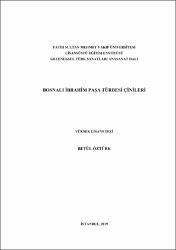Bosnalı İbrahim Paşa Türbesi Çinileri
Künye
ÖZTÜRK, Betül, Bosnalı İbrahim Paşa Türbesi Çinileri, Fatih Sultan Mehmet Vakıf Üniversitesi Lisansüstü Eğitim Enstitüsü Geleneksel Türk Sanatları Anasanat Dalı, Yayımlanmamış Yüksek Lisans Tezi, İstanbul 2019.Özet
16. yüzyılın ilk yarısından 17. yüzyıl ortalarına kadar en parlak dönemini yaşayan
Osmanlı sanatının, gelişen üslup, renk ve motif çeşitleriyle zenginleşmesi ile zaman
içerisinde pek çok alanda ve yapıda kullanıldığını görmekteyiz. Çini sanatının en güzel
örnekleri mimari yapılarda da oldukça fazla yer almıştır. Bu dönem eserlerinden biri
olan Bosnalı İbrahim Paşa türbesi nadide çinili türbe örneklerinden biridir.
Türbenin dış giriş kapısının üstünde iki pano halinde ve türbe içerisinde bütün iç duvar
cephelerini sarar biçimde çiniler yer alır. Türbe içerisindeki süpürgelikler, pencere
kapak arkası, dolap içi çinileri, yazı kuşağı, geometrik geniş bordürler, mihraplı
panolar, rumili ince bordürler ve rölyefli pervazlarıyla muntazam bir işçilik göze
çarpar. Aynı zamanda türbe çinilerinde kullanılan saz üslubu, naturalist üslup,
geometrik ve hatayi tarzı, yazı kuşakları, rölyefli pervaz uygulamalarıyla türbenin çini
kompozisyonu bütünü düşünülerek tasarlanmıştır.
Türbedeki çinilerin teknik, motif ve kompozisyon özelliklerine göre etkilendikleri
üsluplar dikkate alınarak görselleri ile birlikte değerlendirmeleri yapılmıştır. Yapılan
detaylı analizlere istinaden türbenin on altıgen yapısının neredeyse bütün iç duvarlarını
kaplayan çinilerinin genel itibari ile saz üslubunu yansıttığından, diğer üsluplarda ise
az sayıda örnekleri içerdiğinden bahsedilmiştir. Natüralist üslup, geometrik geçmeler,
hatayi tarzı ve yazı kuşağı türbenin geneline yayılmış bir görünüm hissettirse de saz
üslubu eserler daha çok ön plana çıkmaktadır. Bosnalı İbrahim Paşa türbesi çinileri,
yansıttığı dönem özelliklerine, kullanılan üslup ve motiflerin yeri ve önemine binaen
hazırlamış olduğumuz çalışmamızın Türk sanatına katkıda bulunacağı inancını
taşımaktayız. From the first half of the 16th century to the middle of the 17th century, we see that
Ottoman art, which lived its most brilliant period, was used in many fields and
structures with the enrichment of the developing styles, colors and motifs. We also see
that the most beautiful examples of tile art, which also takes place in architectural
structures, is also very much present in this period.
One of the works of this period is one of the rare examples of the tomb of the Bosnian
İbrahim Pasha tomb.There are two panels on the outer entrance door of the tomb and
there are tiles in the tomb that surrounds all the interior walls.Inside the tomb, skirting
boards, window cover, interior tiles, writing belt, geometric wide borders, mihrab
panels, rumi pattern thin borders, relief moldings and a steadyingly workmanship
stands out. At the same time, the tomb's tile composition is designed as a whole with
its reed style, naturalist style, geometric and error style, writing belts, relief moldings
used in tomb tiles.
Evaluations were made by considering the styles that the tiles in the tomb were affected
according to their technical, motif and composition characteristics and According to
the detailed analysis of the ten hexagonal structure of the tomb covering almost all the
interior walls of tiles in general reflects the style of Saz, in other styles are mentioned
that contain a small number of examples. Naturalist style, geometric transitions, hatayi
style and writing belt feel the spread of the entire shrine, the reed-style works are more
prominent. We are convinced that our work, which was prepared due to the
characteristics of the period that Bosnian İbrahim Pasha tomb reflects and the style
and motifs used in these tiles, will contribute to Turkish art.Key words: Tomb, tile,
geometry, saz style ,Bosnian İbrahim Pasha.



















